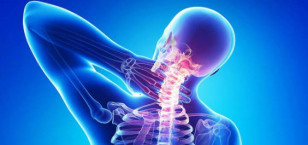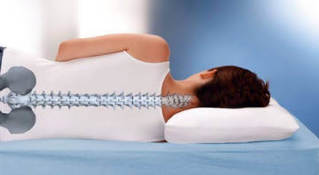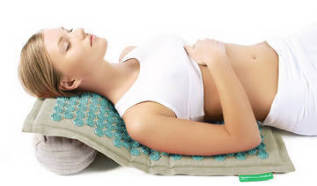
Cervical spinal tumors are a progressive process of dystrophy, breaking up the disc.
Symptoms of osteosarcoma are characterized by severe pain in the neck, head, and shoulders and affect everyone, regardless of age.
OSTEOCHONDROSIS DESCRIPTION
The cervical tumor is much younger. Young people get it from adolescence. The neck is the weakest area of the spine. The seven vertebrae are quite contiguous, and the skeleton of the muscles is poorer than the rest. The neck is under great pressure because it supports the skull and is always in motion.
What are cervical fibroids? The discs are nourished by diffusion from neighboring tissues. The blood supply to the tissues surrounding the vertebra is impaired resulting in lack of nutrients and water. Starvation of the disc nucleus and annular fibrosis leads to the degenerative process.
Overgrowth of bone tissue near the vertebrae, a pinched disc, pinched nerves and ligaments appear first signs of decreased performance. Intense pain is initially concentrated in the neck, head, shoulders, heart, arms, upper chest, then moved to lower extremities. Each of the seven vertebrae sends a signal to the other organs. The compressed nerve roots influence the state of other body systems.
Osteochondrosis is especially dangerous for the brain. The vertebral artery running here functions to supply blood to the back parts of the brain. Pinching it leads to a headache, which often develops into a migraine, without the need for pain relievers. Osteoporosis may be accompanied by dizziness, impaired vision and hearing, nausea and vomiting. Then, symptoms in the throat appear, suddenly fainting due to lack of oxygen supply to the brain. Compression of the vertebral artery leads to ischemia of the spinal cord and brain. Aggravating process causes spinal stroke.
BASIC PROCEDURES FOR TREATMENT
The cervical tumor needs to be considered from an interactive perspective of physiological and pathological factors:
- Physiological processes
- :the aging of the spinal cartilage occurs due to natural irreversible causes. Changes occur in the center part of the disc. The process of the body changes with age leading to the replacement of tooth marrow with fibrous tissue; Pathological process
- :there are degenerative changes in the structure of the disc, destroying surrounding vessels and nodes. The changes occur outside the cartilage itself, compressing blood vessels, stimulating nerve ends. A person feels abdominal pain, pain symptoms of a local and reflective nature.
Cervical spinal tumors are a form of pathology where physiological aging is replaced by a pathological process. At first, the body's compensatory and protective mechanisms are activated, eliminating disease. Therefore, bone necrosis may or may not occur infrequently. But this function is not permanent.
Progression of the disease, manifested in compression of blood vessel and nerve structures, is accompanied by the following processes:
- spondylolisthesis, in which the spinal disc is slipped. Even a slight shift leads to the development of paralysis. Severe displacement causes death;
- kernels are coated with calcium salts. This leads to malnutrition of the disc, causing the formation of a hernia;
- disc herniation is formed by protrusion of the intervertebral disc. Skipping treatment leads to soft paralysis;
- the appearance of microscopic cracks in the annular filament, the development of bulging eyes. The disc protrudes beyond its bounds; Degenerative vertebra
- , means that the vertebra are worn out. Osteophytes appear - the growth of bone tissue in the form of hooks and spines, localized on the sides of the vertebral body. Pain is severe and results in stiffness in movements.
REASONS NECK OSTECHONDROSIS

An increase in the load on the cervical spine leads the body to try to compensate for the condition. This is how the muscle spasms, impaired blood circulation, malformations begin. The structure of the vertebrae also changes. It may also be progressive degenerative disc disease due to prolonged exertion.
Key factors provoking the onset of cervical osteonecrosis:
- reduced motivation;
- weakens the immune system;
- intolerable physical activity;
- presence of spinal injury;
- lack of essential nutrients, obesity;
- postural problems (scoliosis, flat feet, rheumatism); Genetic factors
- ;
- autoimmune diseases that cause cartilage degeneration;
- stress, prolonged nervous tension;
- climatic factors, cold and humidity;
- birth defect of the spine.
The main cause of osteonecrosis is the disproportionately distributed load on the spine, and a weak muscular bra. People over the age of thirty are most at risk, especially if their whole day sits for a long time.
DEVELOPMENT STAGE
Progression of cervical spondylolisthesis can be divided into several stages:
- first, preclinical.Characterized by slightly deformed vertebrae, smooth neck vertebrae. Painful sensation when a sudden, tired head movement occurs. The development of the disease can be prevented without medication. You need to balance your diet, choose exercises and take preventive measures;
- second.An unstable state is established between vertebrae. There is a displacement of the vertebrae relative to each other, twisting - around the spine. The intense pain of neck movement occasionally spreads down the shoulders and arms. The height of the intervertebral discs decreases, resulting in compression of the nerves. It is characterized by signs such as distraction, fatigue, headache;
- the third stage.The height of the spacer disc is reduced by a quarter from the top disc. Defects began to appear in disc joints. There is a decrease in the lumen of the disc, spinal canal. Feeling intense pain all the time. The arm muscles begin to stiffen as the herniated disc has begun to form. The neck spine loses flexibility. The patient feels dizzy and weak.
The height of the disc is significantly reduced. The discs are destroyed and replaced with connective tissue. Large bone cells are formed in the back of the cervical spine. The spinal canal narrows a lot, provoking the development of myelopathy. The patient's condition worsens, accompanied by impaired coordination, dizziness, severe pain, tinnitus.
SYMPTOMS
Symptomatic visualization of neck damage differs from disorders of other parts. This is due to the denser arrangement of the vertebrae in comparison to each other. Due to the small height of the disc, the clinic begins to present even mild conditions. Signs of injury will vary depending on which nerve roots are affected. There is a nerve under each of the seven vertebrae, and its compression has its own symptoms.
Problems in the first two vertebrae affect the sensitivity of the occipital bone. Pain localized in the apical region, occipital region. Nerve defeat of the third vertebra is very rare. Symptoms are manifested by a feeling of numbness in the pinched area, problems with the tongue, speech problems. 4th root indicates pain and numbness in collarbone and shoulder problems. May create shortness of breath, pain in the heart. Diseases of segment 5 cause pain in the neck and shoulders, reducing the sensitivity of the limbs.
Sixth and seventh vertebral injuries are the most common patients. Neck, shoulder blades, forearms, lower back, back pain. There is numbness in the hands and fingers. Pathological changes in the eighth nerve root are characterized by diffuse pain in the lower extremities. The skin loses sensitivity, the little fingers on the hands and feet are numb. Impaired blood circulation causes the feet and hands to appear blue.
The most common signs of cervical bone necrosis are:
- pain spreading to the upper body and lower body;
- weak, reducing the hand sensitivity;
- difficult to move, rattled;
- impaired coordination, accompanied by ringing, tinnitus, feeling of disorientation, weakness, dizziness;
- nausea, vomiting;
- numbness of the tongue, fingers and toes, impaired hearing and vision.
CALCULATION FOR AN ANIMAL DIAMETER
To identify damaged disc and their severity, the doctor needs to conduct a series of tests: X-rays, MRI, CT (computed tomography), two-sided ultrasound. The most accurate way to check for cervical spine health is a magnetic resonance imaging (MRI) scan. The purpose of an MRI is to identify pathological changes in the tissues of the spine, especially the spinal cord and herniated disc. After examining and questioning the disease, the neurologist makes a preliminary diagnosis and prescribes treatment.
TREATMENT

If you suspect osteonecrosis you should consult a neurologist. The duration of the course of treatment depends on the person's age, the severity of cervical necrosis, the type of therapy, and the patient's adherence to all doctor's recommendations. Serious forms of bone necrosis cannot be completely cured. The aim of complex treatment is to slow down the ongoing pathological process, eliminate symptoms. Therapy can be conservative, surgical, or a combination of the two. If the headaches become more frequent, then treatment should be started as soon as possible.
There are two main types of treatment for cervical osteonecrosis:
- The drug
- , is taken by mouth; Physiotherapy
- includes UHF courses, electrophoresis, ultrasound, magnetotherapy, laser therapy. They work to stimulate blood flow, metabolism and reduce muscle spasm.
To weaken the compression of the peripheral central nervous system (CNS) regions and ease pain syndrome at the time of exacerbation, drug therapy is used. After the elimination of acute manifestations of cervical bone necrosis, treatment is not stopped. Physiotherapy is prescribed. Need to regularly massage the neck area. Folk remedies are also used.
INFLUENZA MEDICINE
Drug therapy is only effective when combined with other methods, for example, with physical therapy exercises (exercise therapy), massage. The drug is designed to relieve pain, restore cartilage tissue regeneration and activate blood circulation in the affected neck tissues.

Many doctors prescribe injections to be more effective on nerve endings. But it is best to take vitamins in pill form because the injection is very painful. To provide anti-inflammatory effect, the doctor will administer intramuscular injection.
Main treatment drugs:
- Nonsteroidal anti-inflammatory drugs (NSAIDs).They have analgesic, aseptic inflammation, and root edema. With clear signs of the disease, injections are carried out twice a day with these drugs. Use topically a cream;
- chondroprotectors.Activate metabolism, regenerate cartilage tissue. Eliminate damage to the intervertebral discs. There are injectable drugs for the inside of joints and muscles. The course of treatment is carried out for up to 4 months;
- vitamins of group B (B1, B2, B6), E, A, C, Dhelp to improve metabolism in tissues, catalyze their recovery; Muscle relaxants
- .To relax spasmodic muscles. The tablets are used for a month. In the severe form of the disease, many injectable drugs are used;
- drug to activate blood flow in the brain,rheological properties of blood.
The following substances are used as a supplement to speed up the recovery process:
- angioprotectors- injectable form of drugs designed to activate blood flow in the veins, enhancing vascular tone;
- glucocorticosteroid- to reduce edema and inflammation in the injection form; biological stimulant
- .Accelerates metabolism, helps restore damaged tissues.
PHYSICAL THERAPY
Physical therapies complementary to drug therapy, significantly increasing the speed of recovery, prolonging remission, and reducing the frequency of exacerbations.
Physical therapy method:

- Exercise therapyis one of the most effective treatments for osteonecrosis. Regular exercise activates blood circulation, helping to repair damage;
- massageimproves nerve conduction, restores muscle tone;
- magnetotherapyreduces tissue edema; The
- laser therapy works with a focused optical beam. Starting recovery processes in the body;
- acupressure- activates certain points. Strengthens the immune system, reduces spasms and neck pain; Ultrasound
- for analgesic, anti-inflammatory effects; Electrophoresis
- by medicinal herbs.Electric current promotes the penetration of drug ions into a particular place.
To get rid of cervical necrosis, manual therapy, thermotherapy, mud therapy are also used. All of these methods slow the progression of the disease.
It is not possible to cure osteonecrosis with herbs, but with the main therapy they will help alleviate the condition. Mix 2 teaspoons of honey with two mummies. Heat this mixture, place it on a warm towel, and wrap it around your neck at night. Honey's bio-stimulating properties make it perfect for the treatment. To grind, you use alcohol made from radish, vodka and honey in the ratio of 1, 5: 0, 5: 1, measured with a glass. You can twist three large lemons in a meat blender with four cloves of garlic. Fill the mixture in a two liter bottle with boiling water. After mixing the ingredients, drink half a glass on an empty stomach. The pain can also be relieved by warm compresses with mustard, pepper plaster.
HEALTH EXERCISE
During recovery you can do neck therapy exercises. Exercise therapy is based on a number of active exercises. You should not exercise during exacerbations. When performing the exercises, should monitor the occurrence of discomfort, it is unacceptable.
From a tummy position, use your arms to lift the upper body. Delay for 1-2 minutes. Lower to the starting position and repeat 2-3 times. Then, you need to stretch your arms along your body. Do a right and left turn 6-7 times, trying to touch the floor with your ear. Sit down. Lean forward while inhaling, head tilted toward chest. When breathing out, bend backwards, tilt your head back. Enough of 10-15 degrees. Now you need to place the palms on the forehead and apply pressure to each other for 30 seconds. Repeat 2-3 times. Turn the head 10 times in each direction. If your head starts spinning, the exercise should be interrupted.
COMPLAINTS

The cervical area has many blood vessels, nerve ends that feed the brain. Lightly squeezing them also harms the whole body, disturbs blood circulation in the brain and causes neurological disorders: migraines, heart problems, respiratory system, eyesight, hearing, increased blood pressure. . Particularly dangerous are complications in the form of spinal artery syndrome, cerebral ischemia, spinal stroke, arising from a progressive disease in the neck. When there is an underlying disease, mobility is lost. Spinal cord compression causes death.
To avoid surgical intervention in the treatment of fibroids of the cervix, patients should not delay their examination as soon as the first sign. It is necessary to use all available therapies, as well as make changes in lifestyle and nutrition.












































